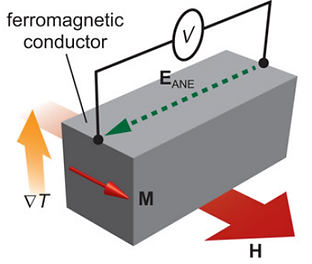Spin Thermoelectrics
1. Spin Seebeck Effect
The spin Seebeck effect (SSE) is a heat-to-electricity energy conversion that uses pure spin currents in a paramagnetic (PM)/ferromagnetic (FM) bilayer structure (Fig. 1). This structure generates thermoelectric conversion transversely, and can thereby overcome the shortcomings of the classical devices with longitudinal geometry that exploit the Seebeck effect. Our group aims to develop new highly-efficient SSE materials and devices. First, we will conduct fundamental research to better understand interactions among heat, electrons, and magnetism in solids. Next, considering that the thermal conduction and electrical conduction can be separately manipulated in the SSE structures, in contrast to the conventional Seebeck structures, we will investigate use of novel device designs.

Fig. 1 The schematic illustration of the spin Seebeck effect (H : external magnetic field, M : magnetization, delT: temperature gradient, Js : spin current and EISHE : inverse spin Hall effect voltage)
2. Anomalous Nernst effect
The Anomalous Nernst effect (ANE) generates a transverse thermoelectric energy by exploiting a spontaneous magnetization of magnetic materials (Fig. 2). Recently, much research about this field has been performed with a wide range of magnetic materials including topological materials, in which large Berry curvatures contribute to a large ANE by breaking the conventional scaling law of magnetization. Our group aims to develop highly-efficient ANE materials and to provide a viable means to fabricate bulk polycrystalline materials for practical applications. We will also investigate theoretical predictions to support our observations.

Fig. 2 The schematic illustration of the anomalous Nernst effect (H : external magnetic field, M : magnetization, delT: temperature gradient and EANE : anomalous Nernst voltage)
3. Magnetism-induced thermoelectrics
The use of magnetic interactions in the Seebeck materials is also rapidly expanding to push the limit of its thermoelectric efficiency. For instance, a few researchers have introduced magnetic nano-inclusions in the thermoelectric material to increase their thermoelectric efficiency. Other magnon- or spin-related novel phenomena have demonstrated the effects of magnetism on thermoelectrics. Our group aims to appreciably increase thermoelectric efficiency by combining such magnetism-related phenomena with conventional thermoelectric materials to exceed their limits. In future research, we will also try to reveal the underlying physical mechanism to focus on magnetism-induced scattering in solids.
J. Phys.: Condens. Matter 26 (2014) 343202
